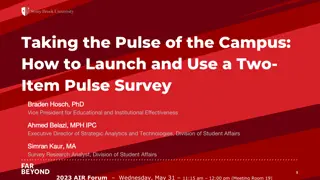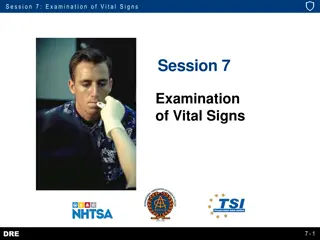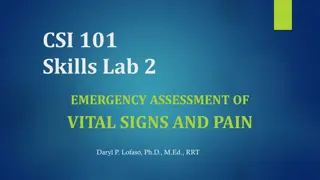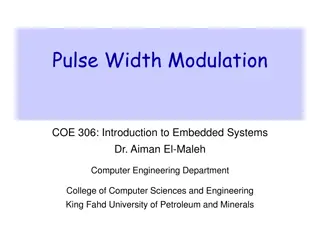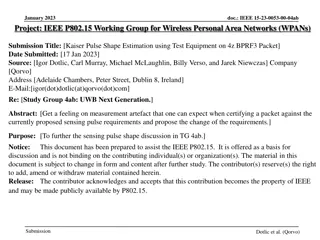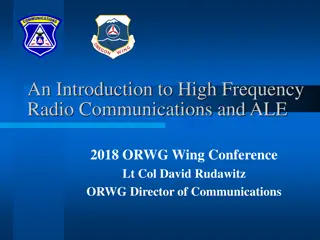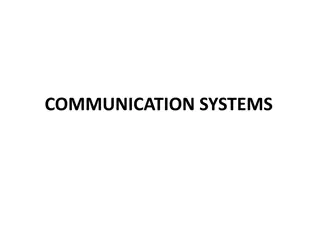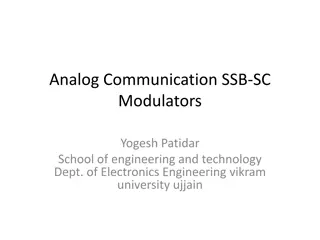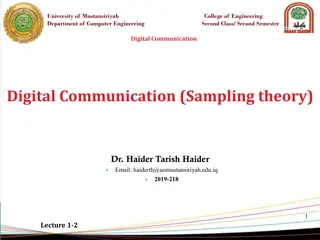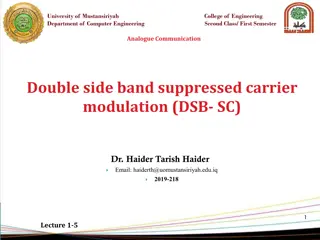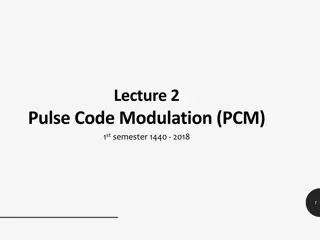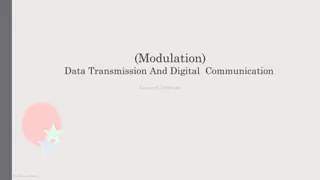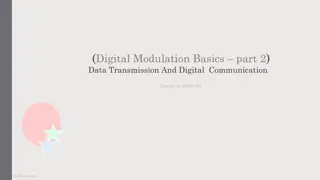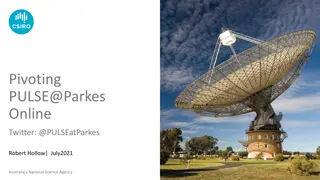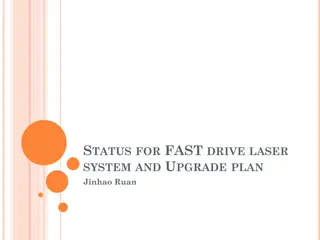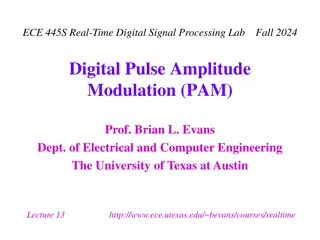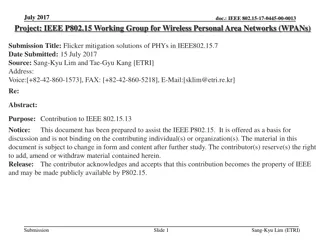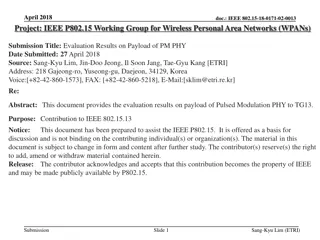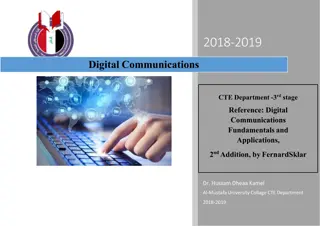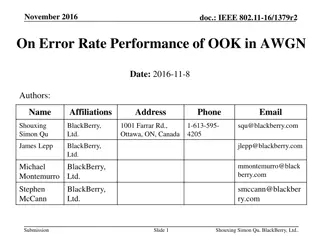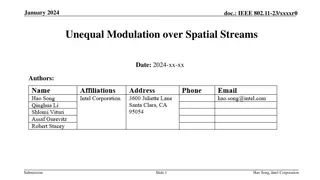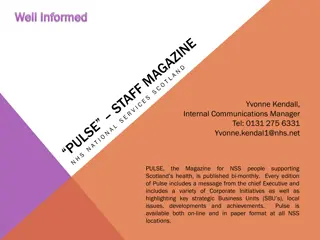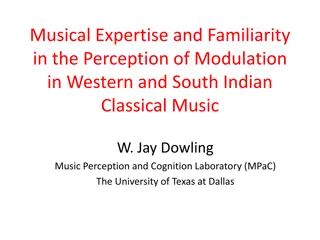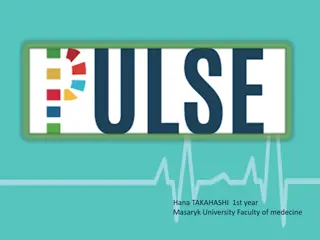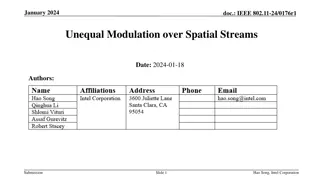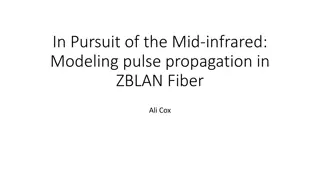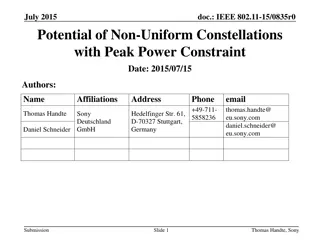Launching Efficient Pulse Surveys in Higher Education
Improve survey research efficiency in higher education by implementing frequent pulse surveys with just one question. Explore the benefits of a weekly pulse survey to gather insights, monitor community stability, and engage stakeholders. Discover the Net Promoter Score (NPS) framework and learn how
1 views • 45 slides
Understanding Interpolation and Pulse Shaping in Real-Time Digital Signal Processing
Discrete-to-continuous conversion, interpolation, pulse shaping techniques, and data conversion in real-time digital signal processing are discussed in this content. Topics include types of pulse shapes, sampling, continuous signal approximation, interpolation methods, and data conversion processes
4 views • 14 slides
Laser Cleaning Applications and Technology Overview
Laser cleaning technology offers versatile solutions for various industrial applications, such as mold cleaning, rust and oxide removal, pretreatment, degreasing, and more. By using pulse or continuous wave lasers, different materials can be efficiently cleaned or treated without damage. Pulse laser
7 views • 9 slides
Comparative Analysis of Pulse and Amplitude Modulations in Cellular Applications
Explore the comparison between various pulse modulations like PM1 and PM3, alongside amplitude modulation (AM) in the context of cellular technologies such as 2G, 4G(LTE), and advances in 5G NR. The discussion includes considerations of modulation frequency, duty cycles, and spectrum analysis to und
0 views • 8 slides
Regulation of Energy Homeostasis by AMPK System and Its Modulation Factors
The AMPK system plays a crucial role in regulating energy homeostasis by sensing the cellular AMP:ATP ratio and responding to metabolic stresses that affect ATP production or consumption. AMPK is activated by factors such as hypoxia, glucose deprivation, and metabolic inhibitors, as well as by compo
0 views • 27 slides
Vital Signs Examination Overview
Explore the examination of vital signs in Session 7, covering the purposes, procedures, indicators, and documentation involved. Learn about assessing drug influence on pulse rate, blood pressure, and temperature, as well as key definitions and pulse points. Understand proper procedures for measuring
1 views • 18 slides
Emergency Assessment of Vital Signs and Pain: A Comprehensive Guide
This comprehensive guide outlines the essential aspects of assessing vital signs in emergency situations, including temperature, pulse, respiration, blood pressure, and pain. It covers guidelines, factors influencing body temperature, pulse assessment techniques, abnormal pulse characteristics, and
1 views • 24 slides
IEEE 802.11-20/0456r0: Transmission EVM Requirements for 4k QAM
The document discusses the tradeoff between error vector magnitude (EVM) and transmission power in the context of 4k QAM modulation. It explores the EVM requirements for 4k QAM and addresses issues such as channel estimation errors, modulation and coding scheme (MCS) parameters, and degradation with
0 views • 11 slides
Understanding Pulse Width Modulation in Embedded Systems
Pulse Width Modulation (PWM) is a technique that uses a rectangular pulse wave to modulate the pulse width, controlling power delivery to devices effectively. It involves altering the average value of a waveform by switching it on and off within a specified period. PWM has various applications, from
0 views • 26 slides
Kaiser Pulse Shape Estimation Study in IEEE WPAN Working Group
Discussing the evaluation of sensing pulse requirements for certifying packets in IEEE's WPAN Working Group. The study aims to minimize measurement artefacts and proposes adjustments to pulse shape requirements based on test equipment results. Key observations include asymmetry in the main lobe and
0 views • 5 slides
Understanding High Frequency Radio Communications and ALE
High Frequency (HF) radio communications, specifically using Single Side Band (SSB) modulation, are essential for effective long-distance communication. The components of an HF radio system include a transceiver, antenna, and power source. By utilizing the ionosphere, HF/SSB modulation enables cost-
5 views • 47 slides
Understanding Performance Analysis of Digital Modulation Techniques
Explore the realm of digital modulation techniques such as ASK, FSK, PSK, QPSK, QAM, and more. Learn about bandwidth efficiency, baud rates, minimum bandwidth, and how to calculate them. Discover the importance of M-ary modulation and how it impacts data transmission rates and bandwidth requirements
4 views • 18 slides
Understanding Radio Transmitters: Classifications and Types
This comprehensive guide delves into the world of radio transmitters, covering their classifications based on modulation, service involved, frequency range, and power used. Learn about different types of modulation transmitters, service-specific transmitters, carrier frequency-based transmitters, an
4 views • 26 slides
Understanding SSB-SC Modulation in Analog Communication
Single Sideband Suppressed Carrier (SSB-SC) modulation is a technique in analog communication that transmits a single sideband along with the carrier signal, offering advantages such as reduced bandwidth consumption, increased signal transmission capacity, and lower noise interference. However, the
0 views • 9 slides
Understanding Digital Communication and Sampling Theory in Computer Engineering
Digital communication in the context of computer engineering involves representing information in binary form for transmission. Sampling theory plays a key role in pulse modulation techniques, noise management, and modulation schemes like ASK, PSK, FSK, and QPSK. This course covers various topics su
7 views • 14 slides
Analogue Communication: DSB-SC Modulation in Computer Engineering
Explore the world of Analogue Communication through Double Sideband Suppressed Carrier Modulation (DSB-SC) in the Computer Engineering Department at the University of Mustansiriyah. Delve into lectures covering the fundamentals and intricacies of this modulation technique under the guidance of Dr. H
1 views • 17 slides
Understanding Pulse Code Modulation (PCM) in Analog to Digital Conversion
This content delves into the realm of Pulse Code Modulation (PCM), outlining its significance in converting analog data to digital signals. It covers the process of Analog to Digital Conversion, emphasizing the advantages of digitizing analog signals for improved quality and reduced noise. The steps
0 views • 14 slides
Understanding Digital Modulation in Data Transmission
Delve into the world of digital modulation for data transmission, exploring various modulation schemes, digital-to-analog conversion processes, the importance of digital modulation in mixed networks, and the fundamentals of modulation and demodulation.
0 views • 27 slides
Modulation Schemes for IEEE 802.11bd Range Extension
The document discusses modulation schemes for extending the range in IEEE 802.11bd, aiming for at least 3dB lower sensitivity levels. It highlights the need for an implementation-friendly, proven technology already adopted in IEEE 802.11. The introduction of the MCS0 DCM scheme in 11ax is also cover
0 views • 15 slides
Understanding Modulation in Data Transmission and Digital Communication
Modulation plays a crucial role in data transmission and digital communication by altering the characteristics of a carrier signal based on the message signal. This lecture discusses analog and digital modulation techniques such as AM, FM, PM, and their operations. It covers the basics of amplitude
0 views • 33 slides
Introduction to Quadrature Amplitude Modulation (QAM) in Digital Communication
Quadrature Amplitude Modulation (QAM) is a widely used modulation technique for transmitting data signals onto a carrier in communication systems. It offers advantages like increased efficiency by combining amplitude and phase variations, making it suitable for various radio and data delivery applic
0 views • 15 slides
Signal Encoding Techniques in Networks and Communication
This chapter delves into signal encoding techniques used in digital data transmission, covering key concepts such as encoding schemes like NRZ-L and NRZI, multilevel binary encoding, and biphase encoding. It explores the fundamentals of digital signaling, modulation techniques, and the relationship
3 views • 34 slides
Understanding Microwave Tubes and Klystron Technology
Microwave tubes play a crucial role in high-frequency applications due to their efficiency and operating principles. Conventional tubes face limitations beyond 100MHz, while efficient microwave tubes utilize electron velocity modulation for power conversion. Klystron tubes, such as Reflex Klystron,
4 views • 19 slides
PULSE@Parkes: Engaging High School Students in Astronomy Education
PULSE@Parkes is a program where high school students collaborate with professional astronomers to conduct remote observations using the Parkes radio telescope. The program offers hands-on experiences, online modules, and data sessions for students in years 10-12. Students also have the opportunity t
0 views • 36 slides
High-Speed Laser Drive System Status and Upgrade Plan
Current status of the fast drive laser system includes a running laser with a 3MHz pulse train and a 5Hz repetition frequency. The system allows for easily achieving pulse lengths up to 200-300s, with potential for longer pulses after extensive tuning. The upgrade plan involves utilizing machine lea
0 views • 18 slides
Real-Time Digital Signal Processing Lab: Digital Pulse Amplitude Modulation (PAM)
Introduction to Digital Pulse Amplitude Modulation (PAM) in the context of Real-Time Digital Signal Processing Lab. Topics covered include pulse shaping, symbol mapping, baseband PAM transmission, and more. The content delves into bit-to-symbol conversion, symbol amplitude mapping, symbol period det
0 views • 18 slides
Flicker Mitigation Solutions in IEEE802.15.7 PHYs
Flicker mitigation solutions for PHYs in IEEE802.15.7 were proposed by Sang-Kyu Lim and Tae-Gyu Kang from ETRI. The solutions address issues related to intra-frame flicker, inter-frame flicker, dimming support, and modulation schemes. Techniques such as RLL codes, Manchester coding, and PPM modulati
0 views • 10 slides
Evaluation Results on Payload of Pulsed Modulation PHY for IEEE 802.15-18-0171-02-0013
This document presents the evaluation results on the payload of Pulsed Modulation PHY for TG13, focusing on detection probability, BER vs SNR for header and payload, and coding considerations. It discusses the application of RS code for payload simulations and highlights the adjustments made for suc
0 views • 21 slides
Simulation Results for LC-Optimized PHY Proposal in July 2019
The document presents simulation results for an LC-optimized PHY proposal for TGbb based on G.9991 PHY. It includes details on the simulation setup, frame detection results, header modulation, coding simulation results, payload modulation, and coding simulation results. The setup involved various re
0 views • 18 slides
Understanding Digital Communications Techniques in CTE Department - 3rd Stage
Explore Differential Pulse Code Modulation (DPCM) and Delta Modulation (DM) concepts in digital communications, as outlined in the 2018-2019 curriculum of the CTE Department. Learn about encoding, quantization, error prediction, reconstruction at the receiver end, and the one-bit per sample transmis
0 views • 11 slides
Error Rate Performance of OOK Modulation in AWGN Channels
This document discusses the error rate performance of On-off keying (OOK) modulation in Additive White Gaussian Noise (AWGN) channels, covering both coherent and non-coherent detection methods. The theoretical results and evaluations of OOK modulation in AWGN are reviewed, providing insights into op
0 views • 17 slides
Understanding Heart Rate and Pulse: Key Differences and Measurement
Heart rate, also known as pulse, is the number of times your heart beats per minute. It varies based on factors like age, fitness level, and emotions. Pulse is a direct measure of heart rate. Learn about the differences between heart rate and blood pressure, how to measure heart rate, and what const
0 views • 8 slides
Comparison of Unequal Modulation and Unequal MCS in IEEE 802.11-23
The comparison between Unequal Modulation and Unequal MCS in the context of IEEE 802.11-23 discusses how these techniques handle spatial streams, modulation schemes, and coding rates to optimize throughput and MIMO gains. Unequal Modulation focuses on adjusting modulations per stream based on SNR co
0 views • 10 slides
Pulse: Engaging NHS National Services Scotland Staff
Pulse is the bi-monthly staff magazine of NHS National Services Scotland, aiming to engage its 3,500 diverse staff members across 21 sites. The magazine covers corporate initiatives, strategic business units, local issues, and achievements in the health sector. Through a variety of articles and case
0 views • 8 slides
Understanding Modulation and Tonal Hierarchies in Music Perception
This research explores how expertise influences the perception of modulation in Western and South Indian classical music, focusing on tonal hierarchies, pitch importance, modulation processes, and memory for melodies. Through experiments involving listeners rating probe tones against music excerpts,
1 views • 26 slides
Understanding Pulse Variations in Medical Science
Explore the different types of pulse, from normal to abnormal/pathological, including terms like regularis, aequalis, inaequalis, intercurrens, and more. The variations in pulse characteristics provide insights into a person's health status, with descriptions of strong, weak, slow, irregular, and ot
0 views • 16 slides
Maximizing Throughput in IEEE 802.11 Networks Through Unequal Modulation Strategies
The documents discuss the benefits of using unequal modulation over spatial streams in IEEE 802.11 networks to enhance throughput. Unequal modulation allows for adapting modulation schemes based on Signal-to-Noise Ratio (SNR) conditions, optimizing MIMO gains and coding rates for each spatial stream
0 views • 10 slides
Exploring Mid-Infrared Pulse Propagation in ZBLAN Fiber
In the pursuit of mid-infrared light for gas detection applications, this study delves into modeling pulse propagation in ZBLAN fiber, a magical material that allows efficient frequency transformation without light absorption. By utilizing Stimulated Raman Scattering, the process of energy transfer
0 views • 16 slides
Potential of Non-Uniform Constellations for Peak Power Constraint in SC Modulation
This document discusses the potential of non-uniform constellations (NUCs) for single carrier (SC) modulation, focusing on the design of NUCs with 64 signal points to maximize coding gain while adhering to peak-to-average power ratio (PAPR) constraints. NUCs show a significant overall gain of up to
0 views • 19 slides
Exercise Lab - Muscles Fatigue Study and Pulse Response Analysis
This exercise lab involves partner activities such as counting strides, jumping jacks, and push-ups to study muscle fatigue and pulse rate. Hypotheses are formed on resistance impact and pulse response during exercises. Data tables and graphs illustrate the fatigue progression and pulse rates over t
0 views • 9 slides
